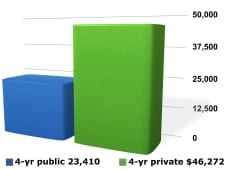There’s no denying the benefits of a college education: the ability to compete in today’s competitive job market, increased earning power, and expanded horizons. But these advantages come at a price–college is expensive. And yet, year after year, thousands of students graduate from college. So, how do they do it?
Many families finance a college education with help from student loans and other types of financial aid such as grants and work-study, private loans, current income, gifts from grandparents, and other creative cost-cutting measures. But savings are the cornerstone of any successful college financing plan.
College costs keep climbing
It’s important to start a college fund as soon as possible, because next to buying a home, a college education might be the biggest purchase you ever make. According to the College Board, for the 2014/2015 school year, the average cost of one year at a four-year public college is $23,410 (in-state students), while the average cost for one year at a four-year private college is $46,272.
Though no one can predict exactly what college might cost in 5, 10, or 15 years, annual price increases in the range of 4 to 7% would certainly be in keeping with historical trends. The following chart can give you an idea of what future costs might be, based on the most recent cost data from the College Board and an assumed annual college inflation rate of 5%.
| Year | 4-yr public | 4-yr private |
|---|---|---|
| 2014/15 | $23,410 | $46,272 |
| 2015/16 | $24,580 | $48,586 |
| 2016/17 | $25,810 | $51,015 |
| 2017/18 | $27,100 | $53,566 |
| 2018/19 | $28,455 | $56,244 |
| 2019/20 | $29,878 | $59,056 |
| 2020/21 | $31,372 | $62,009 |
| 2021/22 | $32,940 | $65,109 |
| 2022/23 | $34,587 | $68,365 |
| 2023/24 | $36,317 | $71,783 |
| 2024/25 | $38,132 | $75,372 |
Tip: Even though college costs are high, don’t worry about saving 100% of the total costs. Many families save only a portion of the projected costs–a good rule of thumb is 50%–and then use this as a “down payment” on the college tab, similar to the down payment on a home.
Focus on your savings
The more you save now, the better off you’ll likely be later. A good plan is to start with whatever amount you can afford, and add to it over the years with raises, bonuses, tax refunds, unexpected windfalls, and the like. If you invest regularly over time, you may be surprised at how much you can accumulate in your child’s college fund.
| Monthly Investment | 5 years | 10 years | 15 years |
|---|---|---|---|
| $100 | $6,977 | $16,388 | $29,082 |
| $300 | $20,931 | $49,164 | $87,246 |
| $500 | $34,885 | $81,940 | $145,409 |
Note: Table assumes an average after-tax return of 6%. This is a hypothetical example and is not intended to reflect the actual performance of any investment. All investing involves risk, including the possible loss of principal, and there can be no guarantee that any investing strategy will be successful.
College savings options
You’re ready to start saving, but where should you put your money? There are several college savings options, and it’s smart to consider tax-advantaged strategies whenever possible. Here are some options.
529 plans
529 plans are one of the most popular tax-advantaged college savings options. They include both college savings plans and prepaid tuition plans. With either type of plan, your contributions grow tax deferred and earnings are tax free at the federal level if the money is used for qualified college expenses. States may also offer their own tax advantages.
With a college savings plan, you open an individual investment account and select one or more of the plan’s mutual fund portfolios for your contributions. With a prepaid tuition plan, you purchase tuition credits at today’s prices for use at specific colleges in the future–there’s no individual investment component. With either type of plan, participation isn’t restricted by income, and the lifetime contribution limits are high, especially for college savings plans.
Note: Investors should consider the investment objectives, risks, charges, and expenses associated with 529 plans before investing. More information about specific 529 plans is available in each issuer’s official statement, which should be read carefully before investing. Also, before investing, consider whether your state offers a 529 plan that provides residents with favorable state tax benefits.
Coverdell education savings accounts
A Coverdell education savings account is a tax-advantaged education savings vehicle that lets you contribute up to $2,000 per year. Your contributions grow tax deferred and earnings are tax free at the federal level (and most states follow the federal tax treatment) if the money is used for the beneficiary’s qualified elementary, secondary, or college expenses. You have complete control over the investments you hold in the account, but there are income restrictions on who can participate.
U.S. savings bonds
The interest earned on Series EE and Series I saving bonds is exempt from federal income tax if the bond proceeds are used for qualified college expenses. These bonds earn a guaranteed, modest rate of return, and they are easily purchased at most financial institutions or online at www.treasurydirect.gov. However, to qualify for tax-free interest, you must meet income limits and other criteria.
UTMA/UGMA custodial accounts
An UTMA/UGMA custodial account is a way for your child to hold assets in his or her own name with you (or another individual) acting as custodian. Assets in the account can then be used to pay for college. All contributions to the account are irrevocable, and your child will gain control of the account when he or she turns 18 or 21 (depending on state rules). Earnings and capital gains generated by assets in the account are taxed to the child each year.
Under the kiddie tax rules, for children under age 19, and for full-time students under age 24 who don’t earn more than one-half of their support, the first $1,050 of earned income is tax free, the next $1,050 is taxed at the child’s rate, and anything over $2,100 is taxed at your rate.
A last word on financial aid
Many families rely on some form of financial aid to pay for college. Loans and work-study jobs must be repaid (either through monetary or work obligations), while grants and scholarships do not.
Most financial aid is based on need, which the federal government and colleges determine primarily by your income, but also by your assets and personal information reported on your aid applications. In recent years, merit aid has been making a comeback, so this can be good news if your child has a special talent or skill.
The bottom line, though, is don’t rely too heavily on financial aid. Although it can certainly help cover college costs, student loans make up the largest percentage of the typical aid package. Generally, plan on financial aid covering the following percentage of expenses: loans–up to 50%, grants and scholarships–up to 15%, work-study–varies. The lesson: the more you focus on your savings now, the less you may need to worry about later.
 |
Colburn Financial ®Mike Colburn Financial Planning Specialist 1084 West Oakland Ave Johnson City, TN 423-930-4021 [email protected] colburnfinancial.com |
| IMPORTANT DISCLOSURES: Colburn Financial does not provide specific tax, or legal advice. The information presented here is not specific to any individual’s personal circumstances.To the extent that this material concerns tax matters, it is not intended or written to be used, and cannot be used, by a taxpayer for the purpose of avoiding penalties that may be imposed by law. Each taxpayer should seek independent advice from a tax professional based on his or her individual circumstances.These materials are provided for general information and educational purposes based upon publicly available information from sources believed to be reliable—we cannot assure the accuracy or completeness of these materials. The information in these materials may change at any time and without notice. |
[et_bloom_inline optin_id=optin_6]


